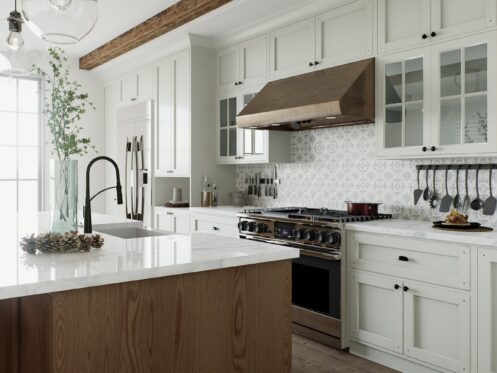That delicious aroma from your stovetop shouldn’t linger for hours and shouldn’t leave a greasy film on your cabinets. When you cook, heat, steam or smoke food, tiny particles get released into the air and tend to linger if your kitchen doesn’t have proper ventilation. A well-chosen range hood helps clear the air and keeps your kitchen more comfortable.
Why Kitchen Ventilation Matters More Than You Think
You might not notice the air in your kitchen until something burns or the smoke alarm goes off. But even on a good day, cooking adds heat, moisture, grease, and particles to the air around you. Every time you sauté onions or boil water, your stove releases more than just steam. That vapor sticks to walls, settles on cabinets and ends up in your lungs. Without proper ventilation, those small moments build up and change the way your kitchen feels and smells.
When food odors linger in the air, they don’t just affect how a space smells, but they stick around and settle on surfaces. Grease from cooking floats up and eventually lands on cabinets, walls and anything nearby. A well-working range hood helps trap that buildup early, keeping your air fresher and your kitchen easier to clean.
Ducted vs Ductless: What You Should Know Before Buying
The first big decision you’ll face is whether your range hood should connect to a duct or recirculate air through a filter. Ducted systems pull air out of the kitchen and send it outside. Ductless hoods draw air through a filter and push it back into the room. Both types work, but they serve different needs.
If your kitchen already has a duct, you’re in a good position to go with a vented hood. This setup does a better job removing smoke, heat and steam because it doesn’t try to filter everything. It just moves it outside. You’ll notice less moisture during long boils and fewer odors after searing something in a pan. But a ductless hood might make more sense if your kitchen layout doesn’t allow for ductwork. These models rely on charcoal filters to grab grease and the smell before returning air to the room.
You need to clean or replace the filters regularly with ductless hoods or they lose their ability to trap particles. That’s something to keep in mind when choosing between convenience and performance. Either way, the best choice depends on how your kitchen is built and what kind of cooking you do most often.
Getting the Right Size for Your Cooking Style
It’s easy to pick a hood that looks nice but doesn’t match the way you cook. Range hoods come in different widths, heights, and power levels, and not all of them suit every setup. If your hood doesn’t match your stove size or power, it can leave smoke and heat behind instead of capturing it. You want something wide enough to cover the cooking surface and strong enough to pull air from across the burners.
If you mostly use one pot at a time, you probably don’t need the most powerful hood on the market. But if you cook several things at once, use high heat or make a lot of dishes that sizzle, you’ll need better airflow. A stronger fan helps manage both the heat and the combustion byproducts for gas stoves, which burn hotter than electric ones. In some cases, going a little wider than the stovetop gives you better coverage. The size of the hood doesn’t just affect how it looks, but it shapes how well it works in your space.
Noise Levels Can Make or Break Daily Use
The sound of the fan can either blend into the background or take over the room. If you’ve ever had a conversation interrupted by a loud kitchen fan, you already know how frustrating that can be. The volume usually depends on the speed setting.
Most hoods let you adjust the fan from low to high. Almost any hood makes noise at full speed, but some stay quieter than others, thanks to better design or insulation. When you’re shopping, look for models with multiple speed settings so that you can run the fan lower when you don’t need maximum power. That helps you use it more consistently instead of avoiding it because of the sound. Listen to a few different hoods in person before buying one. A low hum might be fine for short bursts, but a deep roar can make you turn the fan off.
Placement and Mounting Height Affect Performance
How far your range hood sits above the stovetop affects how effectively it captures rising air. Mount it too high, and steam or smoke might escape before the fan can catch it. Set it too low, and it could interfere with your cooking space. Manufacturers usually suggest a specific height based on the kind of cooktop you have. Gas stoves usually require more clearance than electric ones because of their higher heat output.
Style Should Follow Function, Not the Other Way Around
A range hood can be a centerpiece or a quiet part of the background. Either way, it still must work. Some people choose a hood based on the style first — maybe they want a sleek look or a minimalist finish. That’s fine, if the performance matches. The fan strength, filter type and duct connection matter just as much as the material or shape.
You’ll see wall-mounted hoods, under-cabinet models, island hoods and downdraft systems. Each one has pros and cons. Island hoods hang from the ceiling and can look striking, but they need strong airflow since they’re surrounded by open space. Downdraft vents pull air downward instead of up, but they usually don’t move as much air and can struggle with taller pots or pans.
Cleaning and Maintenance Matter More Than You Expect
No matter which kind of hood you get, it needs regular cleaning to work well. The fan pulls in everything from steam to smoke to airborne grease. That grease doesn’t just disappear. It sticks to filters, fan blades and interior surfaces. If you don’t clean it out, the buildup can block airflow or even drip onto your stovetop.
Some hoods come with metal mesh filters that you can wash by hand or in the dishwasher. Others use baffle filters, which work well for heavy-duty cooking and are easier to clean. Ductless models also include carbon filters that need replacement every few months, depending on how often you cook.
Spring and fall are good times to clean your hood and check the filters. If the air doesn’t seem to move as well as it used to, it’s probably time to clear out the buildup. A clean hood keeps your air moving, your fan quieter and your kitchen smelling fresh.
Let Us Help With Your Kitchen Ventilation Needs
Kitchen ventilation doesn’t have to be complicated, but it does need to be done right. A range hood that fits your space and habits can improve indoor air quality, reduce mess and make cooking a more rewarding daily task. Environmental Heating & Air Solutions in Benicia, CA, helps homeowners find the right ventilation solutions for cleaner indoor air.
Since 2010, we have been providing high-quality service to homeowners, including full cooling and heating services. For help with ventilation solutions, reach out to Environmental Heating & Air Solutions.

